
07 Apr End of Season 2023 and 2024 Reports
By Taylor LaTulipe
Fashionably late!
Better late than never!
The rookery has been busy over the last two seasons. You came to the right spot for a recap! Let’s take a look at some population trends and statistics observed in our native bird rookery.
A “rookery” can be described as a common area for breeding birds or animals. The St. Augustine Alligator Farm Zoological Park provides unique nesting sites for native coastal, wading birds who use our zoo as a safe haven. The birds have an incredible relationship with the 150 alligators who live in the Swamp habitat at the park. The alligators act as a built-in security system for the birds so that predators, such as racoons and snakes, aren’t as inclined to climb up the tree trunks and prey upon the eggs and/or new hatchlings. The many bird species also feel safer nesting in large groups so that they aren’t a target for other predators, such as birds of prey.
The notable wading bird species observed in the park are: great egret (Ardea alba), snowy egret (Egretta thula), cattle egret (Bubulcus ibis), roseate spoonbill (Platalea ajaja), great blue heron (Ardea herodias), tri-colored heron (Egretta tricolor), black-crowned night heron (Nycticorax nycticorax), yellow-crowned night heron (Nyctanassa violacea), green heron (Butorides virescens), little blue herons (Egretta caerulea), white ibis (Eudocimus albus), and the federally threatened wood stork (Mycteria americana). Below you will find graphs that display peak nest count trends of green heron, roseate spoonbills, and wood storks from 2007-2024.
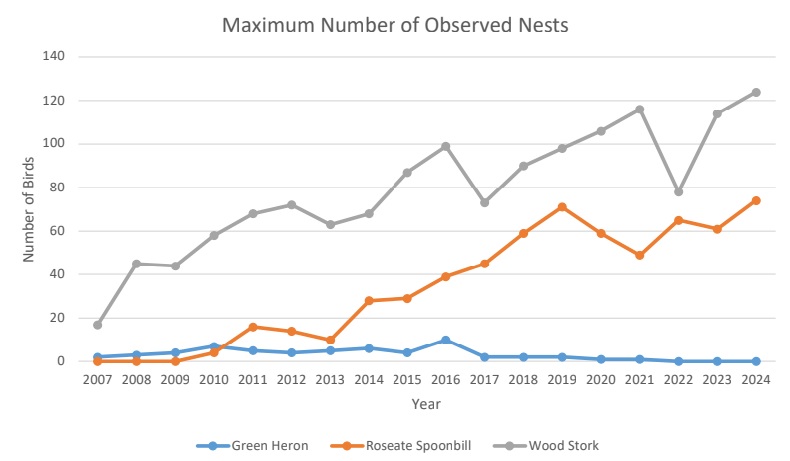
We observed our highest number of wood stork nests (at 124 nests), spoonbill nests (at 74 nests), and wood stork chicks (at 208 chicks). Record numbers, wow! A very successful season, indeed!
Now, let’s look at the overall trends of adults, nests, and chicks of wood storks for the 2023 season from February to June. Note the graph below with seasonal fluctuations for three variables (adults/juveniles, nests, and chicks present).
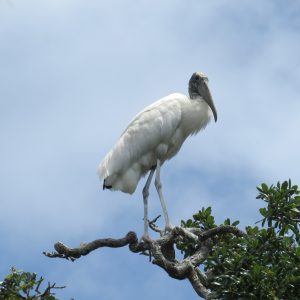
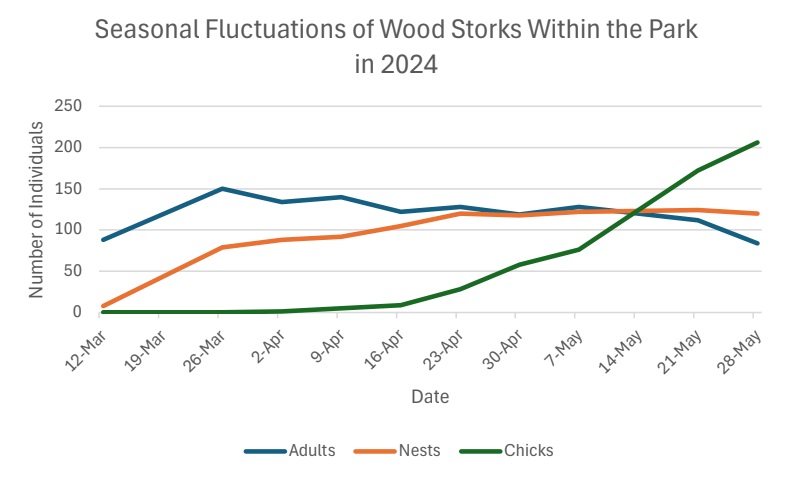
Our highest observed number of wood storks this season was 161 individuals on April 18, 2023 and the highest chick count was 167 individuals on May 30, 2023. Wood storks and their conservation as a species is really important and has a complex history. Wood stork populations plummeted and were suffering in the 1970s largely due to human activity and the shift in water flow around the Everglades region (Bodine & Bodine, 2022). However, thanks to conservation efforts, the wood stork population was downlisted from federally endangered to threatened in 2014 (U.S. Fish & Wildlife Service, 2023).

Photo by Barbara Saffir
Roseate Spoonbills are also incredibly important for the balance, overall, within a coastal ecosystem. Spoonbills get their unique name from the shape of their beak, which they use to feed by swinging their head back and forth in the water looking for small fish and/or crustaceans. A group of spoonbills is called a “bowl” and we are very thankful to have such a large “bowl” nesting on property each year. Below you will find the seasonal trends for spoonbill adults, nests, and chicks for the
2024 nesting season from March to May.
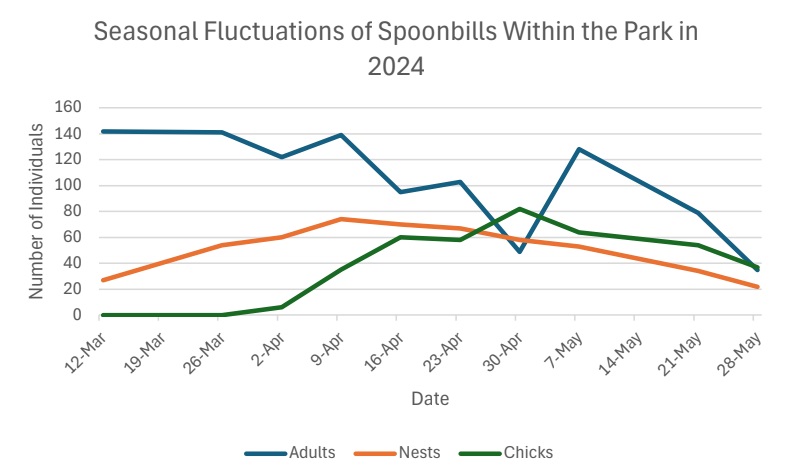
Our highest observed number of spoonbills this season was 142 individuals on March 12, 2024, and the peak chick count was 82 individuals on April 30, 2024.
We have a number of banded birds who can be observed throughout the season in our bird rookery. Make sure to take note of their band number and report any sightings! You and I are all contributing to the success and survival of these birds and we should do our part to preserve and protect these fragile species.
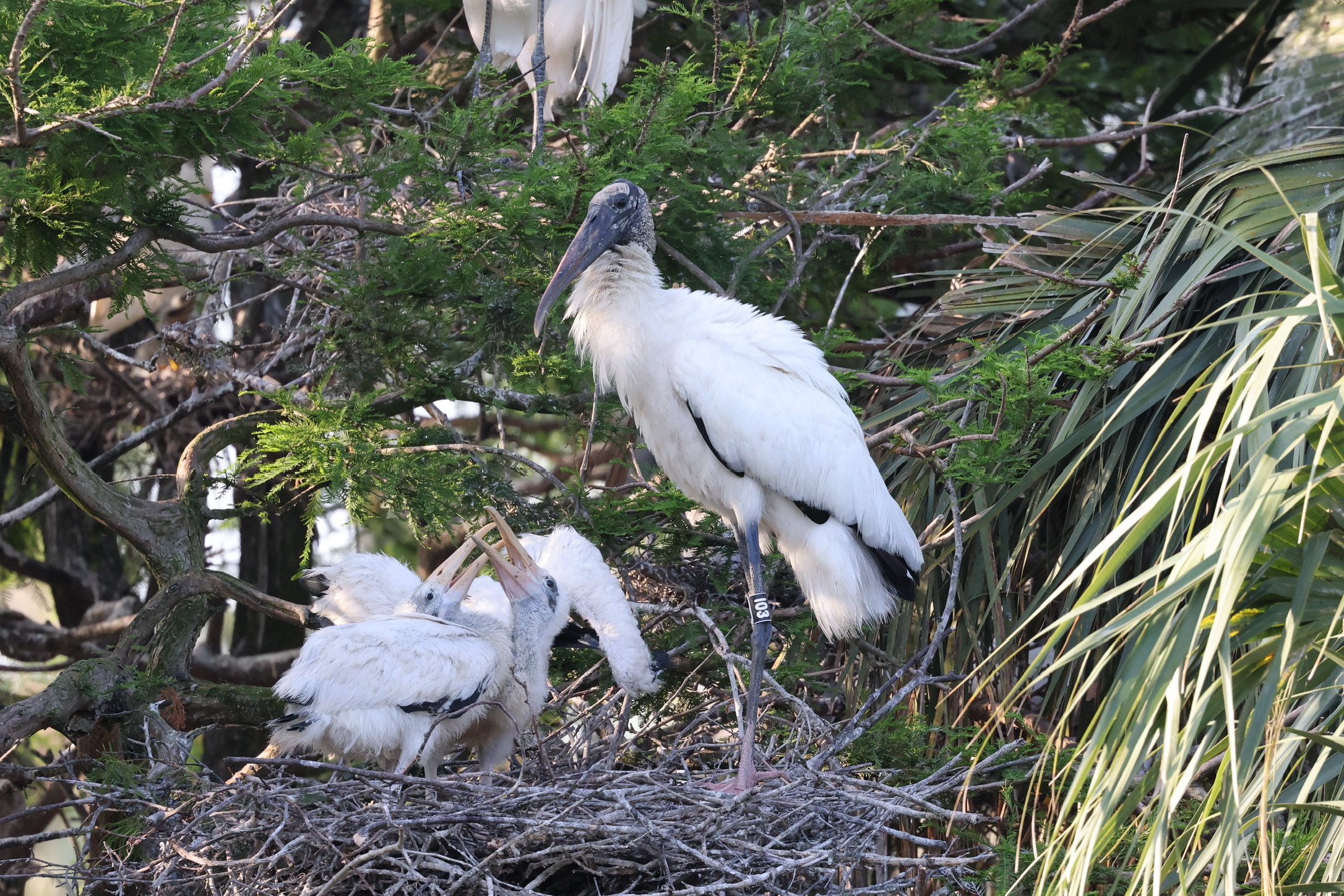
Wood stork 103 banded as a chick in the St. Augustine Alligator Farm rookery 5/9/17. Pictured here successfully raising chicks in May 2023. Photo by Karen Willes
The 2025 season has welcomed the opening of a new bathroom facility in the bird rookery with stunning views of the nesting birds. Make sure to check it out the next time you are at the zoo!
Happy birding! <3
Citations
Renee Bodine, & Bodine, I. R. (2022, June 24). Saving the wood stork: U.S. Fish & Wildlife Service. FWS.gov. https://www.fws.gov/story/2022-06/saving-wood-stork
Service proposes delisting the wood stork: U.S. Fish & Wildlife Service. FWS.gov. (2023, February 14).
https://www.fws.gov/press-release/2023-02/service-proposes-delisting-wood-stork
